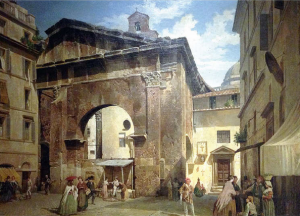BOOKS Inside and Outside the Ghetto
“Dentro e fuori dal Ghetto” (“Inside and Outside the Ghetto” published by Mondadori Education), the new book written by Micol Ferrara, professor of Jewish studies at the BA offered by the Union of Italian Jewish Communities (UCEI), is not just a history textbook, it`s deeper than that. Bypassing the barriers of distance and time, Ferrara describes the topography of the ghetto of Rome in the modern age, and virtually rebuilds the buildings of the neighborhood where for centuries Jews were confined. Among other things, she focuses on the Ghettarello, the part of the ghetto that disappeared and was recently rediscovered by the scholar Giancarlo Spizzichino (1938-2014). She writes about the relationships between Christians and Jews through the eyes of converts.
The book was presented at the Museum of Rome in Trastevere with the participation of Gianni Di Domenico, head of Mondadori Education; Martine Boiteux (École française de Rome); Claudio Canonici (Seminary “A. Trocchi”); Michael Gasperoni (École française de Rome) and Carlo Maria Travaglini (Roma Tre University), on a panel introduced by Myriam Silvera, coordinator of the UCEI BA in Jewish Studies. The event was attended by many historians including Anna Foa, who wrote the preface of the book; and David Kertzer, author and expert in the relations between Jews and the Catholic Church. Kertzer`s book, “The Kidnapping of Edgardo Mortara” inspired the script of the next Steven Spielberg movie.
“As an editor at Mondadori Education,” said Gianni Di Domenico “I can admit that I have read the book over and over again. This is far more than a history book.”
Martine Boiteux added: “The first use of the word ‘ghetto’, was in the 1700s. According to the Academia della Crusca (the most prestigious academy for the study of Italian language) ‘ghetto’ was the place where Jews had to live. Over the years the definition has been refined over and over to signify segregation. After the ghetto of Rome was demolished in 1870, it became an almost affectionate way of referring to a Jewish neighborhood.”
“Ferrara,” said Boiteux “used a lot of data and sources: a job that emerges in the digital part of the book with its multimedia reconstructions. The two most innovative parts are the chapters devoted to Ghettarello and the one devoted to the Jews who converted to Catholicism.”
“I fully agree with the method used by Ferrara,” added Carlo Maria Travaglini. “It was a combination of historical, social, economic and cultural approaches which has enhanced the data emerging from the study of the topic.”
Michael Gasperoni also added: “With her book, Ferrara brought down another wall; the wall that stands between the different disciplines of the social sciences. The ghetto has become a popular object of study.”

